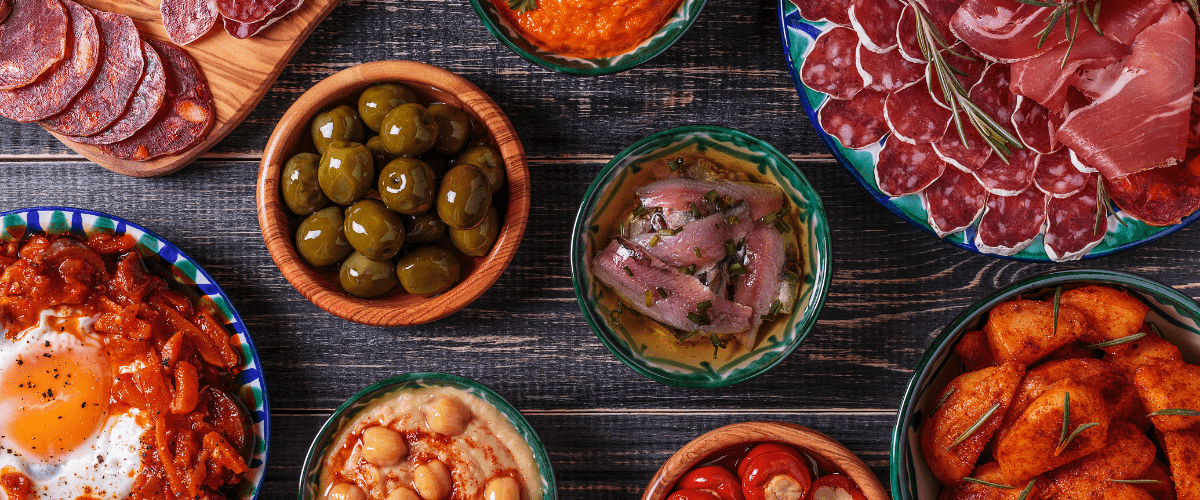Tapas – Spanish Appetizers

Author: Eve Keerus-Jusupov, CEO of Merlis Homes SL.
Helping you navigate Costa del Sol property with confidence and peace of mind.
Have a question? Contact me via WhatsApp
Let’s start with a Spanish lesson. 🙂 The word “tapa” comes from the Spanish word meaning “cover”. In plural, it’s “tapas”, and as a verb, “tapar” means “to cover”.
Tapas have inspired additional terms in Spanish, such as “tapeo”, “tapear”, or “ir de tapas”. There are even tapas tours (tapas hopping), where you visit various bars throughout the evening and sample different tapas along with drinks. We did several tours for this post. 🙂
There are many stories about how tapas became part of Spanish food culture.
Popular Legends about the Origin of Tapas
One of the oldest stories about the history of tapas claims they were first invented in the 13th century. King Alfonso X of Castile recovered from an illness by drinking wine with small dishes between meals. After regaining his health, he decreed that taverns should not serve wine unless accompanied by a small snack, a “tapa”.
In the 16th century, King Philip III believed that eating snacks while drinking reduced drunkenness and required bartenders to serve snacks with drinks. This also reduced tavern fights as both hands were occupied. 🙂
Another theory suggests that in the 18th century or earlier, tavern owners were generally illiterate, meaning they couldn’t write out menus, and if they did, no one could read them! Instead, tavern owners would carry around small samples of their main dishes, served on the pot’s lid (la tapa) they were cooked in.
Another story claims that in the 19th century, King Alfonso XIII visited Cádiz in southern Spain and ordered wine at a local tavern. Because the town was windy and dusty, the waiter placed a slice of ham over the wine glass to keep sand out of the wine. The king liked that he could eat ham with his wine, and the Spanish people copied this style, serving ham with each portion of wine.
It’s also said that in Seville, bartenders would serve sherry, beer, or wine with a small plate on top to keep flies and other insects out. They found that adding a small snack to the plate boosted business. The idea worked, and bars that provided these free snacks with drinks became more popular. The added benefit was that salty snacks made people drink more and faster. Since the plate acted as a cover (la tapa), these snack plates were called tapas.
Another tale is that when the wine was poorly fermented, a free slice of strong cheese was placed on top to mask the bad wine smell.
Regardless of the origin, tapas, or small Spanish appetizers, are an essential part of Spanish cuisine and have spread worldwide. They are served with both alcoholic and non-alcoholic drinks in bars and cafes.

Variety of Tapas
In the old days, a tapas plate was free, and you only paid for the drink. In some Spanish cities like Granada and Madrid, you can still find places that offer free tapas with drinks. However, be prepared to pay separately for tapas plates in most places.
Typically, tapas are enjoyed before a late Spanish dinner, but they can also be a meal in themselves. Sometimes, tapas bars have no chairs, only bar counters or high tables-barrels. In some tapas bars, used toothpicks and napkins are thrown on the floor. Don’t be surprised if the floor isn’t clean.
Where to Eat Tapas in Marbella?
One of our favorite places is Lekune Bar in Marbella (Avda. Fontanilla, s/n – Local 1 Granada Building Marbella). The first time, we thought the tapas were free there too, but when it came time to pay the bill, the waiter counted the toothpicks. Toothpick B was €2 and toothpick C was €2.70. The waiter went around offering different flavors – grilled shrimp in garlic oil, mini burgers, bread with various spreads, croquettes, ham, sausages, etc. One bite here, another there, and this finger food fills you up.
What is Called Tapas?
The most common foods eaten as tapas are salted meats like jamón Iberico or chorizo, serrano ham, seafood, olives, cheeses (usually made from sheep’s or goat’s milk), sardines, anchovies, and other easy-to-prepare items that require little or no cooking.
Very popular are fried potatoes with spicy sauce (patatas bravas), Spanish omelet or potato omelet (tortilla de patatas), meatballs in tomato sauce, or fried calamari rings or octopus.
The main ingredients of a potato omelet are slowly cooked potatoes and eggs, with added chopped onions, peppers, and spicy pork sausages like chorizo.
Tapas bases include savory crackers, slices of bread or loaf, drizzled with a bit of quality olive oil, optionally flavored with garlic, pepper, or basil.
Traditional Spanish Tapas
Boquerones – White anchovies served in vinegar (boquerones en vinagre) or fried.
Gambas al Ajillo – Shrimp fried in lots of garlic-flavored olive oil.
Calamares Fritos – Fried calamari rings.
Albondigas – Meatballs in sauce.
Patatas Bravas – Fried potatoes with spicy sauce.
Croquetas – Spanish croquettes.
Pimientos de Padrón – Fried small spicy peppers.
Pulpo a la Gallega – Galician-style boiled octopus with potatoes and paprika.
Solomillo al Whiskey – Pork or beef medallions cooked in whiskey sauce.
Tortillitas de Camarones – Shrimp omelet.
Tortilla Española – Spanish potato omelet.
Pinchos – Bread pieces with spreads.
Alioli – Special garlic sauce.
Chorizo – Spicy salami.
Marinated olives (aceitunas).
If you’ve never tried tapas, you should definitely come to Spain to do one or more tapas tours.



